

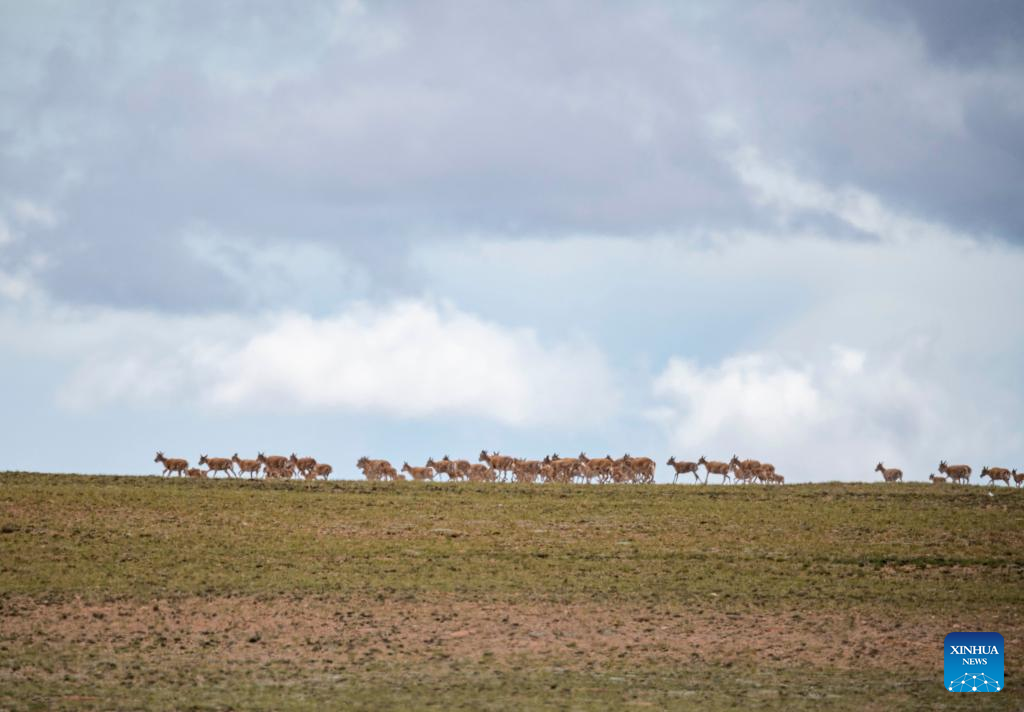
Photo taken on July 11, 2022 shows Tibetan antelopes at the Qiangtang National Nature Reserve in southwest China's Tibet Autonomous Region. Every summer, pregnant Tibetan antelopes escorted by male ones migrate to the nature reserve to give birth, then return to their habitats with their offspring.
The population of Tibetan antelopes in the region has surged from 50,000 to more than 300,000 over the past decades.
Last year, China downgraded the status of Tibetan antelopes from "endangered" to "near threatened," owing to proactive anti-poaching and biodiversity protection efforts. (Xinhua/Sun Fei)
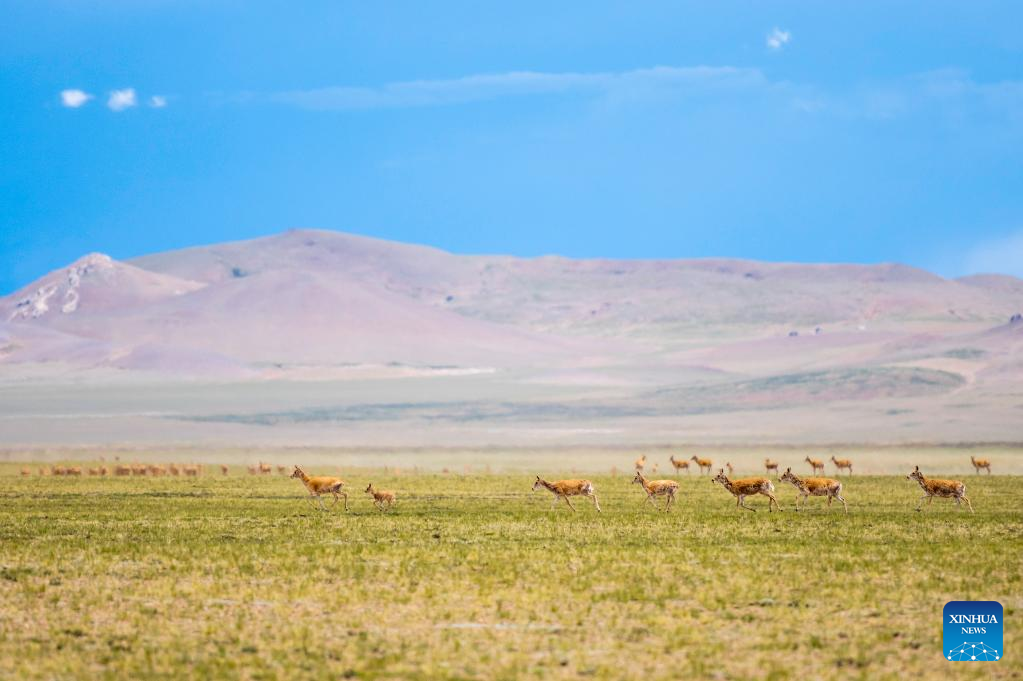
Photo taken on July 11, 2022 shows Tibetan antelopes at the Qiangtang National Nature Reserve in southwest China's Tibet Autonomous Region. Every summer, pregnant Tibetan antelopes escorted by male ones migrate to the nature reserve to give birth, then return to their habitats with their offspring.
The population of Tibetan antelopes in the region has surged from 50,000 to more than 300,000 over the past decades.
Last year, China downgraded the status of Tibetan antelopes from "endangered" to "near threatened," owing to proactive anti-poaching and biodiversity protection efforts. (Xinhua/Zhou Dixiao)
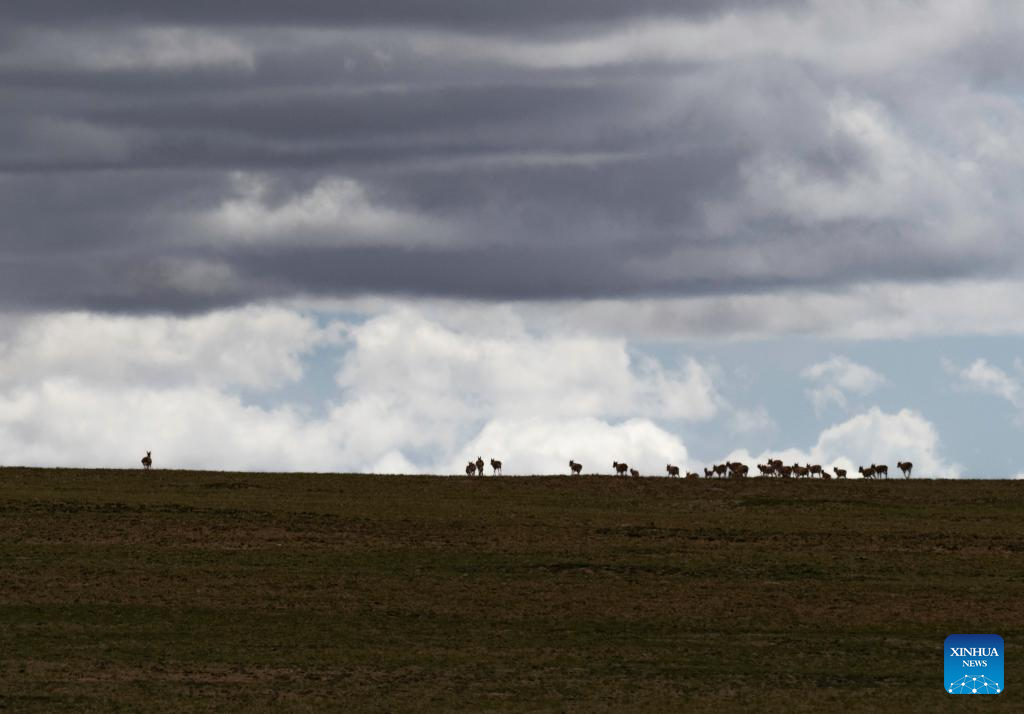
Photo taken on July 11, 2022 shows Tibetan antelopes at the Qiangtang National Nature Reserve in southwest China's Tibet Autonomous Region. Every summer, pregnant Tibetan antelopes escorted by male ones migrate to the nature reserve to give birth, then return to their habitats with their offspring.
The population of Tibetan antelopes in the region has surged from 50,000 to more than 300,000 over the past decades.
Last year, China downgraded the status of Tibetan antelopes from "endangered" to "near threatened," owing to proactive anti-poaching and biodiversity protection efforts. (Xinhua/Zhou Dixiao)

Photo taken on July 11, 2022 shows a newborn baby Tibetan antelope at the Qiangtang National Nature Reserve in southwest China's Tibet Autonomous Region. Every summer, pregnant Tibetan antelopes escorted by male ones migrate to the nature reserve to give birth, then return to their habitats with their offspring.
The population of Tibetan antelopes in the region has surged from 50,000 to more than 300,000 over the past decades.
Last year, China downgraded the status of Tibetan antelopes from "endangered" to "near threatened," owing to proactive anti-poaching and biodiversity protection efforts. (Xinhua/Zhou Dixiao)

Photo taken on July 11, 2022 shows Tibetan antelopes at the Qiangtang National Nature Reserve in southwest China's Tibet Autonomous Region. Every summer, pregnant Tibetan antelopes escorted by male ones migrate to the nature reserve to give birth, then return to their habitats with their offspring.
The population of Tibetan antelopes in the region has surged from 50,000 to more than 300,000 over the past decades.
Last year, China downgraded the status of Tibetan antelopes from "endangered" to "near threatened," owing to proactive anti-poaching and biodiversity protection efforts. (Xinhua/Zhou Dixiao)
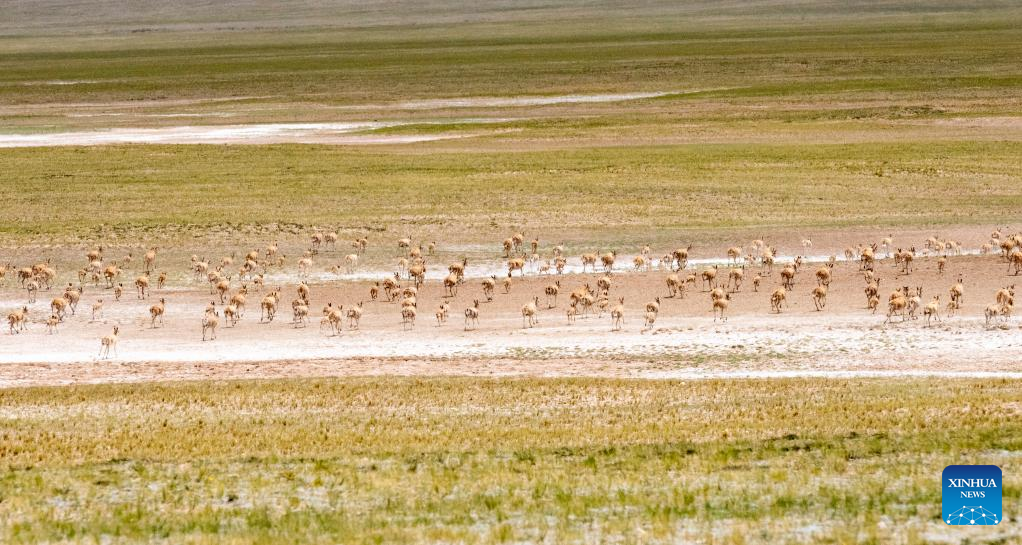
Photo taken on July 11, 2022 shows Tibetan antelopes at the Qiangtang National Nature Reserve in southwest China's Tibet Autonomous Region. Every summer, pregnant Tibetan antelopes escorted by male ones migrate to the nature reserve to give birth, then return to their habitats with their offspring.
The population of Tibetan antelopes in the region has surged from 50,000 to more than 300,000 over the past decades.
Last year, China downgraded the status of Tibetan antelopes from "endangered" to "near threatened," owing to proactive anti-poaching and biodiversity protection efforts. (Xinhua/Zhou Dixiao)

Photo taken on July 11, 2022 shows Tibetan antelopes at the Qiangtang National Nature Reserve in southwest China's Tibet Autonomous Region. Every summer, pregnant Tibetan antelopes escorted by male ones migrate to the nature reserve to give birth, then return to their habitats with their offspring.
The population of Tibetan antelopes in the region has surged from 50,000 to more than 300,000 over the past decades.
Last year, China downgraded the status of Tibetan antelopes from "endangered" to "near threatened," owing to proactive anti-poaching and biodiversity protection efforts. (Xinhua/Sun Fei)
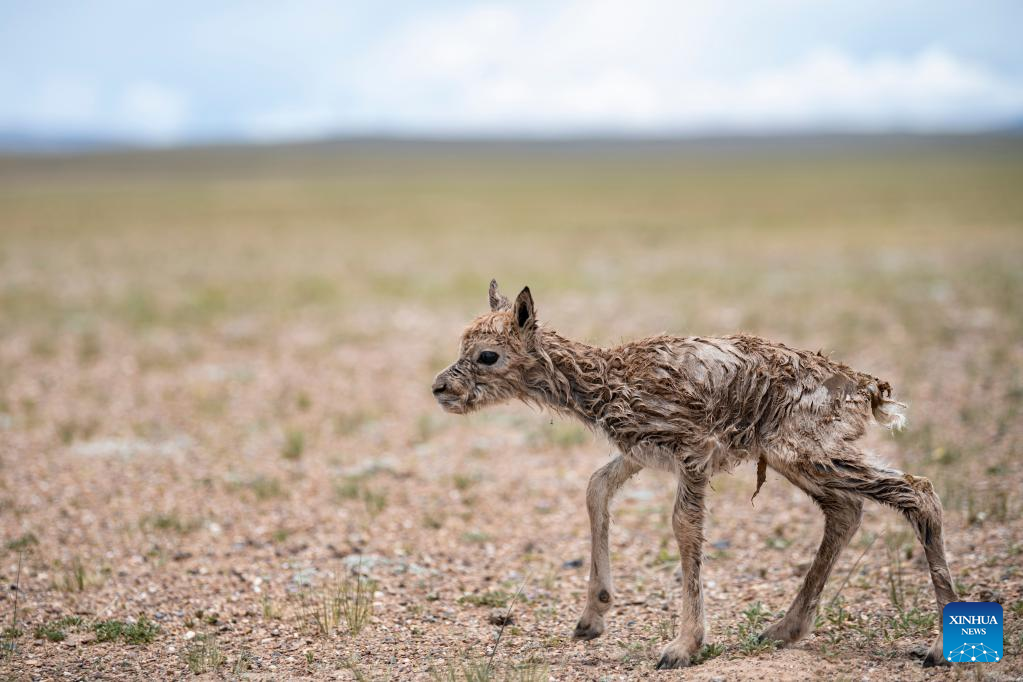
Photo taken on July 11, 2022 shows a newborn baby Tibetan antelope at the Qiangtang National Nature Reserve in southwest China's Tibet Autonomous Region. Every summer, pregnant Tibetan antelopes escorted by male ones migrate to the nature reserve to give birth, then return to their habitats with their offspring.
The population of Tibetan antelopes in the region has surged from 50,000 to more than 300,000 over the past decades.
Last year, China downgraded the status of Tibetan antelopes from "endangered" to "near threatened," owing to proactive anti-poaching and biodiversity protection efforts. (Xinhua/Sun Fei)

Photo taken on July 11, 2022 shows male Tibetan antelopes on alert at the Qiangtang National Nature Reserve in southwest China's Tibet Autonomous Region. Every summer, pregnant Tibetan antelopes escorted by male ones migrate to the nature reserve to give birth, then return to their habitats with their offspring.
The population of Tibetan antelopes in the region has surged from 50,000 to more than 300,000 over the past decades.
Last year, China downgraded the status of Tibetan antelopes from "endangered" to "near threatened," owing to proactive anti-poaching and biodiversity protection efforts. (Xinhua/Jin Meiduoji)
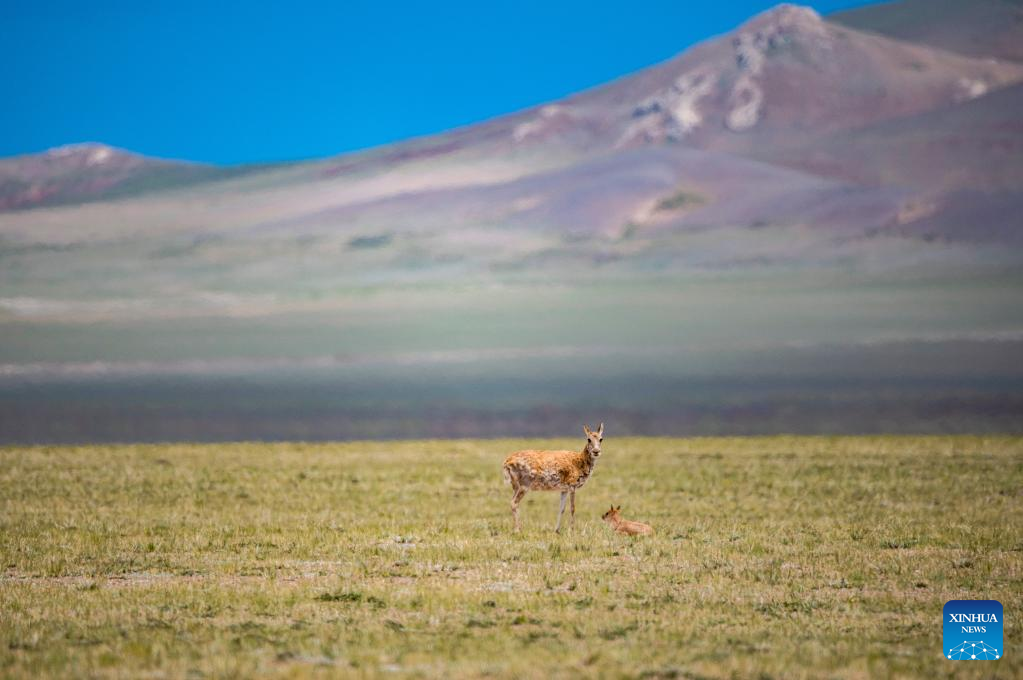
Photo taken on July 11, 2022 shows a female Tibetan antelope taking care of its baby at the Qiangtang National Nature Reserve in southwest China's Tibet Autonomous Region. Every summer, pregnant Tibetan antelopes escorted by male ones migrate to the nature reserve to give birth, then return to their habitats with their offspring.
The population of Tibetan antelopes in the region has surged from 50,000 to more than 300,000 over the past decades.
Last year, China downgraded the status of Tibetan antelopes from "endangered" to "near threatened," owing to proactive anti-poaching and biodiversity protection efforts. (Xinhua/Sun Fei)
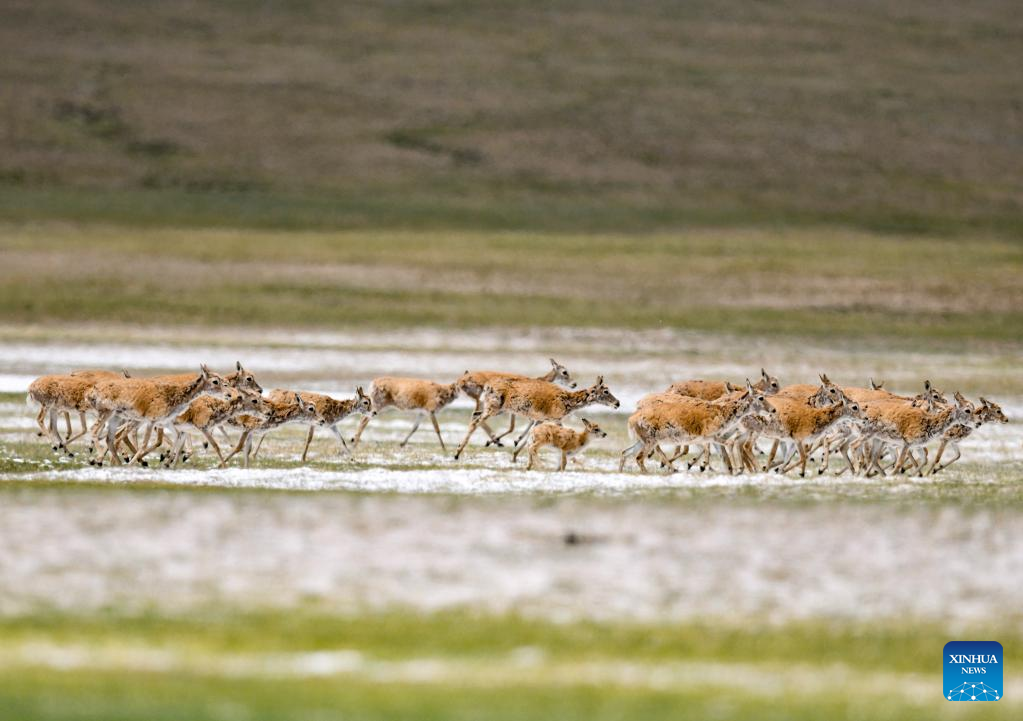
Photo taken on July 11, 2022 shows Tibetan antelopes at the Qiangtang National Nature Reserve in southwest China's Tibet Autonomous Region. Every summer, pregnant Tibetan antelopes escorted by male ones migrate to the nature reserve to give birth, then return to their habitats with their offspring.
The population of Tibetan antelopes in the region has surged from 50,000 to more than 300,000 over the past decades.
Last year, China downgraded the status of Tibetan antelopes from "endangered" to "near threatened," owing to proactive anti-poaching and biodiversity protection efforts. (Xinhua/Jin Meiduoji)
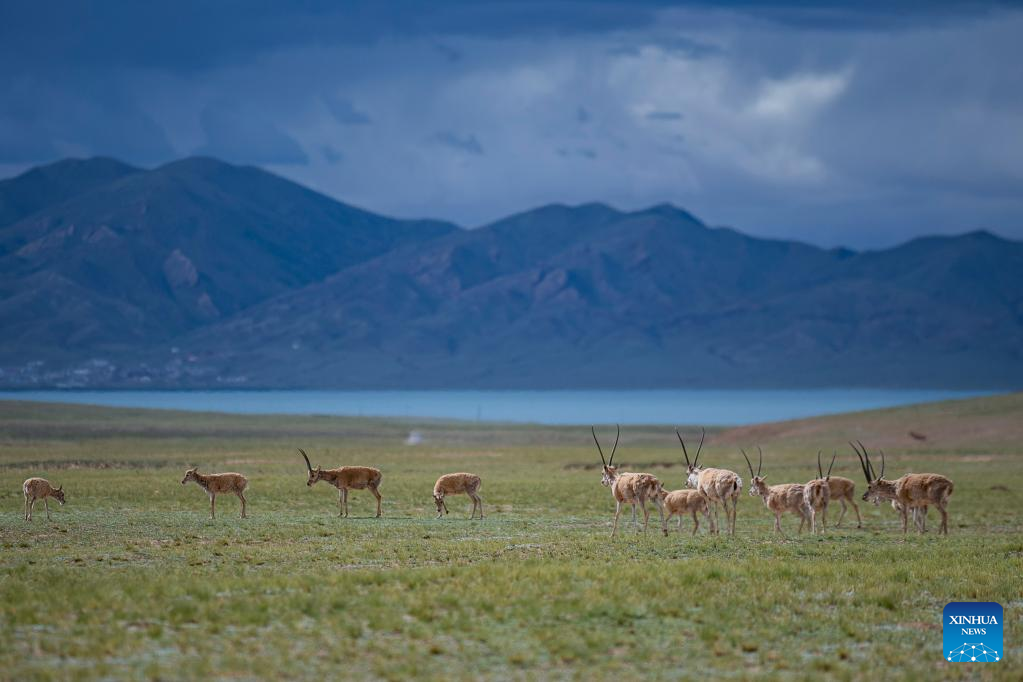
Photo taken on July 11, 2022 shows Tibetan antelopes at the Qiangtang National Nature Reserve in southwest China's Tibet Autonomous Region. Every summer, pregnant Tibetan antelopes escorted by male ones migrate to the nature reserve to give birth, then return to their habitats with their offspring.
The population of Tibetan antelopes in the region has surged from 50,000 to more than 300,000 over the past decades.
Last year, China downgraded the status of Tibetan antelopes from "endangered" to "near threatened," owing to proactive anti-poaching and biodiversity protection efforts. (Xinhua/Sun Fei)
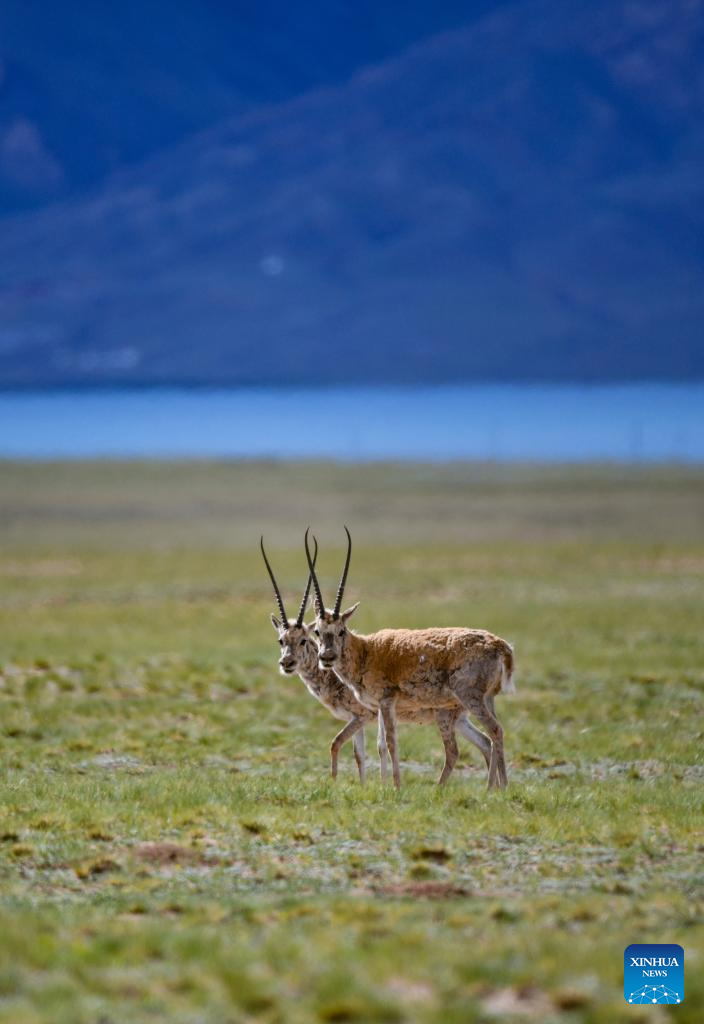
Photo taken on July 11, 2022 shows male Tibetan antelopes on alert at the Qiangtang National Nature Reserve in southwest China's Tibet Autonomous Region. Every summer, pregnant Tibetan antelopes escorted by male ones migrate to the nature reserve to give birth, then return to their habitats with their offspring.
The population of Tibetan antelopes in the region has surged from 50,000 to more than 300,000 over the past decades.
Last year, China downgraded the status of Tibetan antelopes from "endangered" to "near threatened," owing to proactive anti-poaching and biodiversity protection efforts. (Xinhua/Jin Meiduoji)
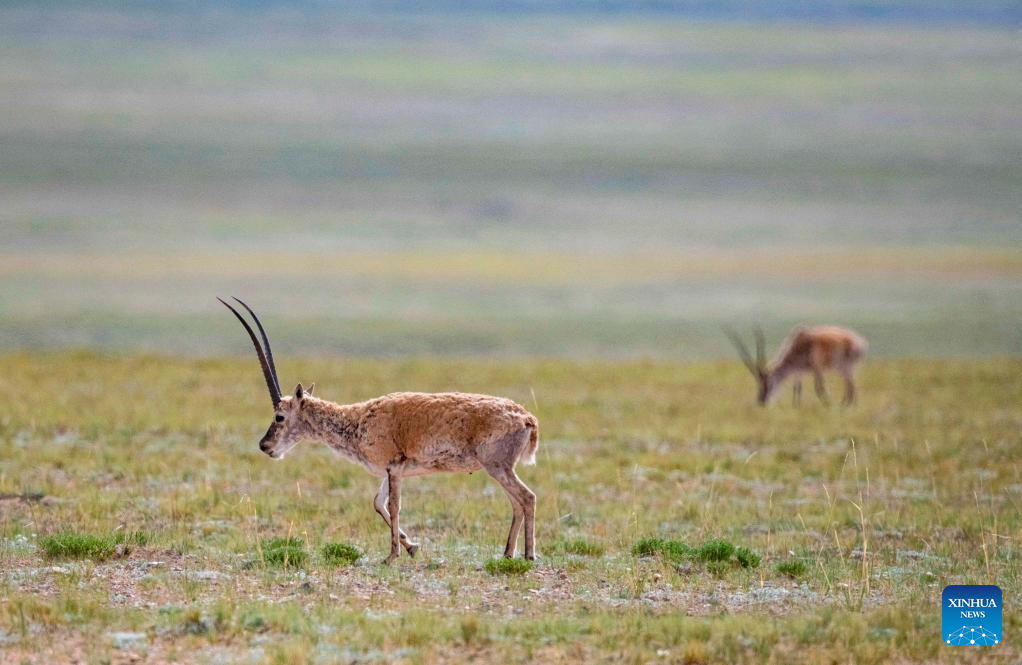
Photo taken on July 11, 2022 shows male Tibetan antelopes on alert at the Qiangtang National Nature Reserve in southwest China's Tibet Autonomous Region. Every summer, pregnant Tibetan antelopes escorted by male ones migrate to the nature reserve to give birth, then return to their habitats with their offspring.
The population of Tibetan antelopes in the region has surged from 50,000 to more than 300,000 over the past decades.
Last year, China downgraded the status of Tibetan antelopes from "endangered" to "near threatened," owing to proactive anti-poaching and biodiversity protection efforts. (Xinhua/Sun Fei)
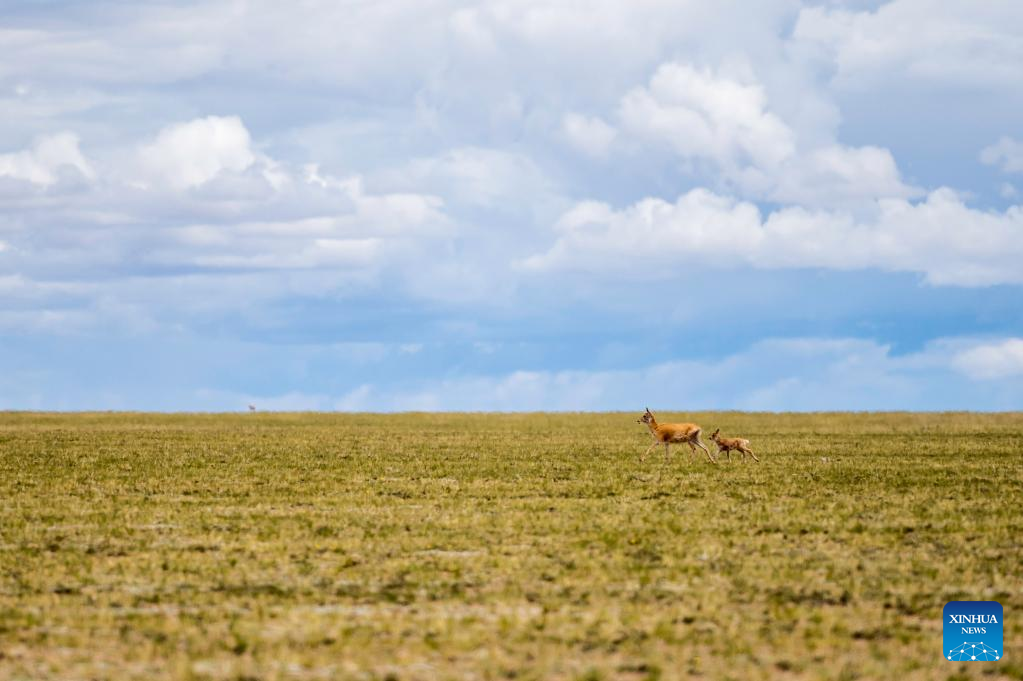
Photo taken on July 11, 2022 shows a female Tibetan antelope taking care of its baby at the Qiangtang National Nature Reserve in southwest China's Tibet Autonomous Region. Every summer, pregnant Tibetan antelopes escorted by male ones migrate to the nature reserve to give birth, then return to their habitats with their offspring.
The population of Tibetan antelopes in the region has surged from 50,000 to more than 300,000 over the past decades.
Last year, China downgraded the status of Tibetan antelopes from "endangered" to "near threatened," owing to proactive anti-poaching and biodiversity protection efforts. (Xinhua/Zhou Dixiao)
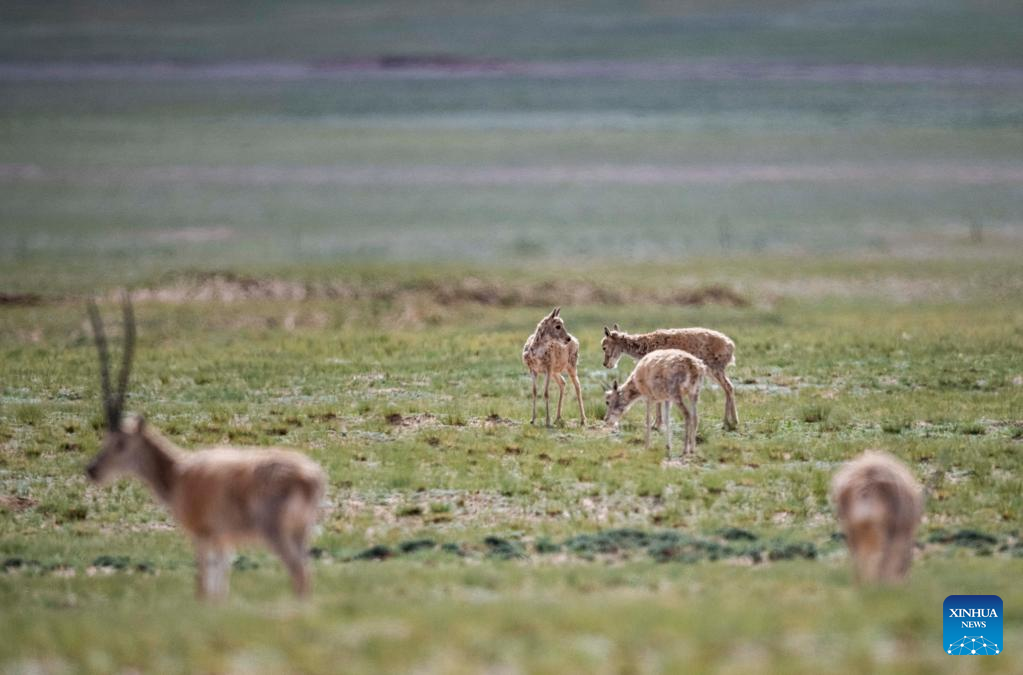
Photo taken on July 11, 2022 shows female Tibetan antelopes grazing while a male Tibetan antelope is on alert at the Qiangtang National Nature Reserve in southwest China's Tibet Autonomous Region. Every summer, pregnant Tibetan antelopes escorted by male ones migrate to the nature reserve to give birth, then return to their habitats with their offspring.
The population of Tibetan antelopes in the region has surged from 50,000 to more than 300,000 over the past decades.
Last year, China downgraded the status of Tibetan antelopes from "endangered" to "near threatened," owing to proactive anti-poaching and biodiversity protection efforts. (Xinhua/Sun Fei)
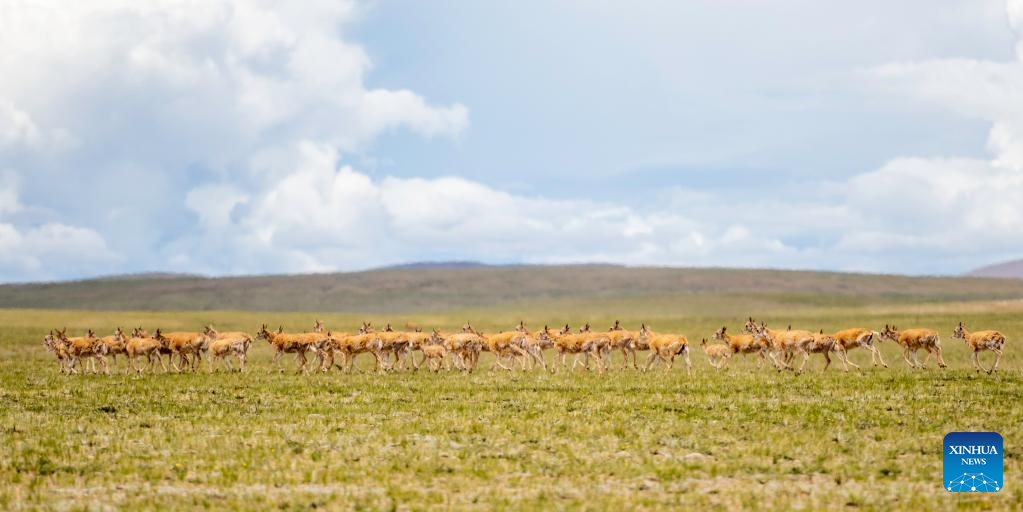
Photo taken on July 11, 2022 shows Tibetan antelopes at the Qiangtang National Nature Reserve in southwest China's Tibet Autonomous Region. Every summer, pregnant Tibetan antelopes escorted by male ones migrate to the nature reserve to give birth, then return to their habitats with their offspring.
The population of Tibetan antelopes in the region has surged from 50,000 to more than 300,000 over the past decades.
Last year, China downgraded the status of Tibetan antelopes from "endangered" to "near threatened," owing to proactive anti-poaching and biodiversity protection efforts. (Xinhua/Zhou Dixiao)
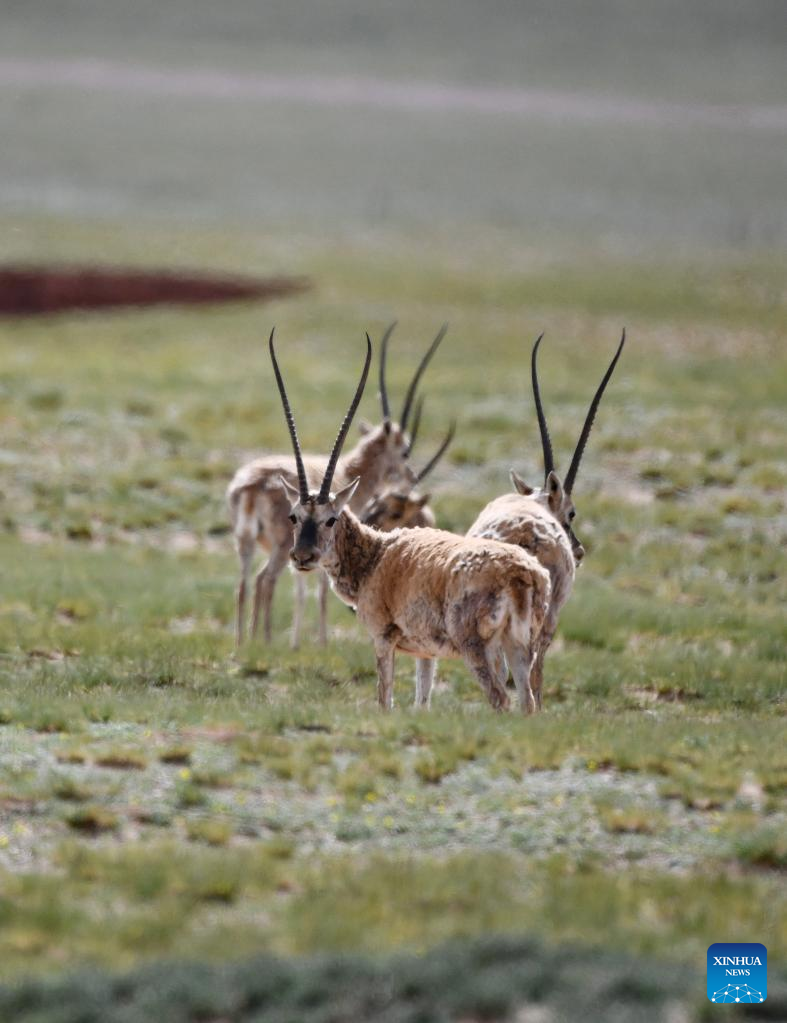
Photo taken on July 11, 2022 shows male Tibetan antelopes on alert at the Qiangtang National Nature Reserve in southwest China's Tibet Autonomous Region. Every summer, pregnant Tibetan antelopes escorted by male ones migrate to the nature reserve to give birth, then return to their habitats with their offspring.
The population of Tibetan antelopes in the region has surged from 50,000 to more than 300,000 over the past decades.
Last year, China downgraded the status of Tibetan antelopes from "endangered" to "near threatened," owing to proactive anti-poaching and biodiversity protection efforts. (Xinhua/Jin Meiduoji)
点击右上角![]() 微信好友
微信好友
 朋友圈
朋友圈

请使用浏览器分享功能进行分享
